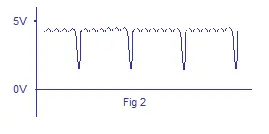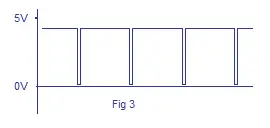Contactless digital tachometer using 8051.
A three digit contact less digital
tachometer using 8051 microcontroller which can be used for measuring
the revolutions/second of a rotating wheel, disc, shaft or anything like
that is introduced in this project. The tachometer can measure up to a
maximum of 255 rev/sec at an accuracy of 1 rev/sec. What you just need
to do is to align the sensor close to the reflective strip (aluminium
foil, white paper or some thing like that) glued on the rotating surface
and the meter shows the rev/sec on the display. The circuit diagram of
the digital tachometer is shown below.
Next
part is the signal conditioning unit based on the opamp LM324 (IC1).
Only one opamp inside the quad LM324 is used here and it is wired as a
comparator with reference voltage set at 3.5V (using resistors R16 and
R17). The job of this comparator unit is to convert the spiky collector
wave form into a neat square pulse train so that it can be applied to
the microcontroller. Every time the collector voltage of the photo
transistor goes below 3.5V, the output of the comparator goes to
negative saturation and every time the collector voltage of the photo
transistor goes above 3.5V, the comparator output goes to positive
saturation resulting in a waveform like this:
From the above two graphs you can see
that the negative going edge of the waveform indicates the passage of
the reflective patch across the sensor and that means one revolution. If
you could some how measure the number of negative going
edges occurring in one second, then that’s the rev/sec of the rotating
object and that’s what the microcontroller does here.
The 8051 microcontroller here does two jobs and they are:1) Count the number of negative going pulses available at its T1 pin (pin15).
2) Do necessary mathematics and display the count on the 3 digit 7 segment display.
For the counting purpose both the timers
of 8051 (Timer0 and Timer1) are used. Timer 1 is configured as an 8 bit
auto reload counter for registering the number of incoming zero going
pulses and Timer0 is configured as a 16 bit timer which generate the
necessary 1 second time span for the Timer1 to count.
Program.
ORG 000H
MOV DPTR,#LUT // moves the addres of LUT to DPTR
MOV P1,#00000000B // Sets P1 as an output port
MOV P0,#00000000B // Sets P0 as an output port
MAIN: MOV R6,#14D
SETB P3.5
MOV TMOD,#01100001B // Sets Timer1 as Mode2 counter & Timer0 as Mode1 timer
MOV TL1,#00000000B //loads initial value to TL1
MOV TH1,#00000000B //loads initial value to TL1
SETB TR1 // starts timer(counter) 1
BACK: MOV TH0,#00000000B //loads initial value to TH0
MOV TL0,#00000000B //loads initial value to TH0
SETB TR0 //starts timer 0
HERE: JNB TF0,HERE // checks for Timer 0 roll over
CLR TR0 // stops Timer0
CLR TF0 // clears Timer Flag 0
DJNZ R6,BACK
CLR TR1 // stops Timer(counter)1
CLR TF0 // clears Timer Flag 0
CLR TF1 // clears Timer Flag 1
ACALL DLOOP // Calls subroutine DLOOP for displaying the count
SJMP MAIN // jumps back to the main loop
DLOOP: MOV R5,#100D
BACK1: MOV A,TL1 // loads the current count to the accumulator
MOV B,#100D
DIV AB // isolates the first digit of the count
SETB P1.0
ACALL DISPLAY // converts the 1st digit to 7 seg pattern
MOV P0,A // puts the pattern to Port 0
ACALL DELAY // 1mS delay
ACALL DELAY
MOV A,B
MOV B,#10D
DIV AB // isolates the secong digit of the count
CLR P1.0
SETB P1.1
ACALL DISPLAY // converts the 2nd digit to 7 seg pattern
MOV P0,A
ACALL DELAY
ACALL DELAY
MOV A,B // moves the last digit of the count to accumulator
CLR P1.1
SETB P1.2
ACALL DISPLAY // converts the 3rd digit to 7 seg pattern
MOV P0,A
ACALL DELAY
ACALL DELAY
CLR P1.2
DJNZ R5,BACK1 // repeats the subroutine DLOOP 100 times
RET
DELAY: MOV R7,#250D // 1mS delay
DEL1: DJNZ R7,DEL1
RET
DISPLAY: MOVC A,@A+DPTR // gets 7 seg digit drive pattern for current value in A
CPL A // (See Note 1)
RET
LUT: DB 3FH // Look up table (LUT) starts here
DB 06H
DB 5BH
DB 4FH
DB 66H
DB 6DH
DB 7DH
DB 07H
DB 7FH
DB 6FH
END
Notes.
1) The LUT used here was made for a common cathode seven segment display (used in previous projects) and here we are using a common anode display. The instruction CPL A will just complement the digit drive pattern in accumulator so that it becomes suitable for the common anode display. This is done just because to save my time but not a text book method. The correct way is to make a dedicated LUT for common anode configuration and aviod the extra CPL A instruction.2) LM324 is a quad opamp and only one opamp inside it is used here. I used LM324 just because that was the only single supply opamp with me at the time. You can use any single supply opamp that matches our supply voltage(5V). You can even use a dual supply opamp (like the popular 741) in single supply mode (+V pin connected to positive supply and -V pin connected to ground) but i wont recommend it unless you have an oscilloscope. Dual supply opamps configured in single supply mode will not give results like a dedicated single supply opamp in the same situation.
3) As we saw earlier the Timer 0 which generates the 1 second time span is configured in Mode 1 (16 bit timer). So the maximum it can count is 2^16 and that is 65536. In 8051 the crystal frequency is divided by 12 using an internal network before applying it as a clock for the timer. That means the timer will increment by one for every 1/12th of the crystal frequency. For an 8051 system clocked with a 12MHz crystal the time taken for one timer increment will be 1µS (ie; 1/12MHz). So the maximum time delay that can be obtained using one session of the timer will be 65536µS and it is looped 14 times to get the 1 second delay. Go through this article Delay using 8051 timer for a better grasp.
4) Also read this article Interfacing seven segment display to 8051 before attempting this project.




No comments:
Post a Comment